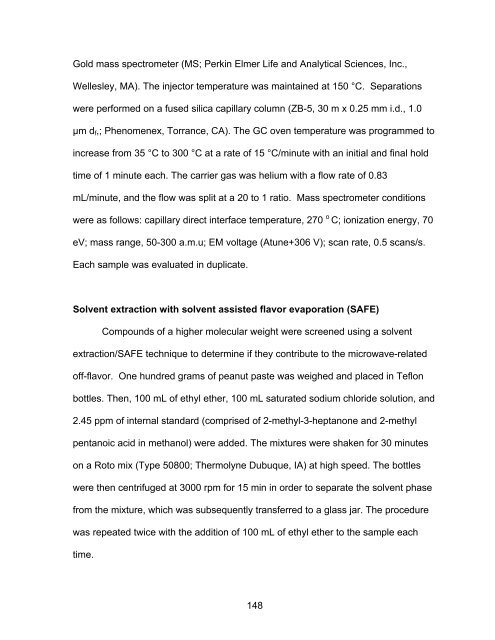Abstract SCHIRACK, ANDRIANA VAIS. The Effect of Microwave ...
Abstract SCHIRACK, ANDRIANA VAIS. The Effect of Microwave ...
Abstract SCHIRACK, ANDRIANA VAIS. The Effect of Microwave ...
You also want an ePaper? Increase the reach of your titles
YUMPU automatically turns print PDFs into web optimized ePapers that Google loves.
Gold mass spectrometer (MS; Perkin Elmer Life and Analytical Sciences, Inc.,<br />
Wellesley, MA). <strong>The</strong> injector temperature was maintained at 150 °C. Separations<br />
were performed on a fused silica capillary column (ZB-5, 30 m x 0.25 mm i.d., 1.0<br />
µm df,; Phenomenex, Torrance, CA). <strong>The</strong> GC oven temperature was programmed to<br />
increase from 35 °C to 300 °C at a rate <strong>of</strong> 15 °C/minute with an initial and final hold<br />
time <strong>of</strong> 1 minute each. <strong>The</strong> carrier gas was helium with a flow rate <strong>of</strong> 0.83<br />
mL/minute, and the flow was split at a 20 to 1 ratio. Mass spectrometer conditions<br />
were as follows: capillary direct interface temperature, 270 o C; ionization energy, 70<br />
eV; mass range, 50-300 a.m.u; EM voltage (Atune+306 V); scan rate, 0.5 scans/s.<br />
Each sample was evaluated in duplicate.<br />
Solvent extraction with solvent assisted flavor evaporation (SAFE)<br />
Compounds <strong>of</strong> a higher molecular weight were screened using a solvent<br />
extraction/SAFE technique to determine if they contribute to the microwave-related<br />
<strong>of</strong>f-flavor. One hundred grams <strong>of</strong> peanut paste was weighed and placed in Teflon<br />
bottles. <strong>The</strong>n, 100 mL <strong>of</strong> ethyl ether, 100 mL saturated sodium chloride solution, and<br />
2.45 ppm <strong>of</strong> internal standard (comprised <strong>of</strong> 2-methyl-3-heptanone and 2-methyl<br />
pentanoic acid in methanol) were added. <strong>The</strong> mixtures were shaken for 30 minutes<br />
on a Roto mix (Type 50800; <strong>The</strong>rmolyne Dubuque, IA) at high speed. <strong>The</strong> bottles<br />
were then centrifuged at 3000 rpm for 15 min in order to separate the solvent phase<br />
from the mixture, which was subsequently transferred to a glass jar. <strong>The</strong> procedure<br />
was repeated twice with the addition <strong>of</strong> 100 mL <strong>of</strong> ethyl ether to the sample each<br />
time.<br />
148

















